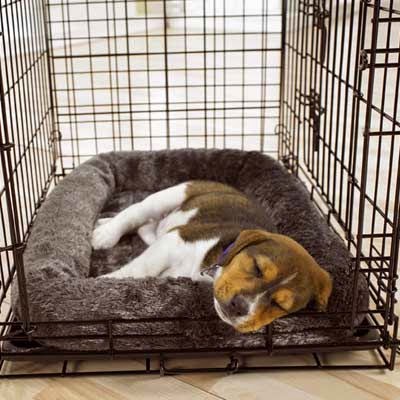How to Crate Train your Dog in 3 Steps
Crate training makes housebreaking simpler, and will be the
foundation for obedience training that follows. Without crate training it is
possible for your pet to develop destructive behaviors such as chewing household
objects. By following these 3 steps, your pet will become confident, outgoing,
and obedient. Crates represent a den environment which is instinctively
comforting to dogs.
Step 1: Buy the crate
 |
| Clearly, these two would require slightly different sized crates. |
It is important when selecting the crate to purchase the proper
size of your fully grown dog. Crates come with dividers that allow you to
increase the available space inside of the crate as your puppy grows. You
should also purchase the crate well in advance of bringing your puppy or dog
home for the first time. Introducing a pet into your home can be chaotic;
having a plan simplifies the process. Many people choose metal wire crates.
Wire crates offer the most visibility and are the easiest to clean. If you need
to clean the crate bottom, the crate pan slides out.
Plastic kennels are also used to crate train dogs. Vari
Kennels are the only type of crate approved for airline travel. If you will be travelling
via car or plane, consider this type of crate. Vari Kennels best resemble the
dens dogs slept in while in the wild.
Tip#1 Send your breeder a small blanket to use with your
puppy and its littermates. When you pick up your puppy, use the blanket inside
of the crate. Your puppy is less likely to cry at night with the familiar
smells of home.
Tip #2 If you buy a wire crate and want to create a better
den like structure, you can buy crate covers. These are cloth covers that drape
over the crate to darken the inside.
Step 2: Accessorize the crate
 |
| A comfortable crate mat can make all the difference! |
A plain crate is unappealing for a dog. When shopping for
your crate, pick up accessories that will make the crate more comfortable. The
first thing you should buy is a crate mat. A crate mat is for dogs, as
mattresses are for humans. Crate mats are available in numerous sizes and
colors, and are machine washable.
Beyond the crate mat, don’t forget to furnish the crate with
toys and chews. No one would enjoy sleeping in an empty room with just a
mattress. Your pet can’t have your iPad, but should have plenty of durable toys
and chews. The brands Kong and Nylabone both offer toys appropriate for all
sizes of dogs, and all levels of chewing.
Step 3 “Kennel Up”
Step 3 “Kennel Up”
Before your pet ever enters the crate, decide on the command
you will use to begin the process. A typical term is “Kennel” or “Kennel Up”. Set
up the crate in a common room then allow your pet to investigate. Rather than
forcing your pet into the crate, allow your pet’s curiosity to explore the new
crate. Strive to develop a positive association with the crate by hiding treats
and toys inside.
To begin formal crate training, give the command “kennel”
and open the crate door. When your pet enters the crate, treat or praise your
pet. Keep your pet inside for only a few seconds at first, then give a release
command such as “here”. The universal truth of obedience training is
consistency. Always use the same commands or you will confuse your dog.
Once your pet is comfortable in the crate, gradually
increase the length of time inside of the crate. Do not expect your pet to
withstand 6+ hours inside of the crate. If you work and no one can walk your
dog during the day, purchase an Exercise Pen that attaches to the crate. An Ex
Pen allows your pet an additional 4’x4’ space to stretch and lie down during
the day.
Last Thoughts
Crates should never be confused with cages.
You should NEVER punish your pet by locking it inside of their crate. You
should NEVER force a dog into the crate. Cages are prisons. Crates mimic dens that
dogs naturally seek out and sleep in.



